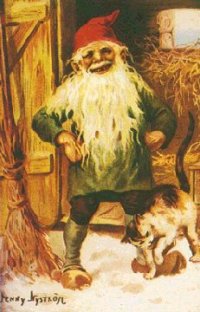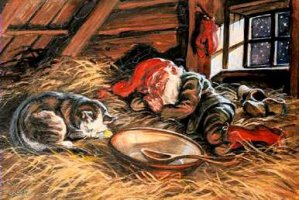
The Swedish tomte is the equivalent of a hob, brownie or house-elf found in other parts of Europe. They live in houses and can be quite helpful, but very nasty if denied their usual salary (porridge with butter on Christmas night) or if he felt offended, after which he would punish people-sometimes harmelss pranks, other times killing those who ate his porridge.

Denmark's house elf, the nisse, started bearing presents on Christmas around the 1840s, and the Swedish tomte followed his example. Jenny Nystrom illustrated the tomte as a more Santa Claus-like figure-wearing red with a white beard (illustrations shown above). He had a goat rather than reindeer, and though over time he's been more and more influenced by the Western Santa Claus, some in Scandinavia still leave out porridge for him (I'd rather have cookies, myself...).
Other Swedish Christmas traditions come from ancient folklore. Long ago people believed that the dead would come back to visit their homes on Christmas, so lights were left on, beds were left open (the people slept on the floor), bath houses were warmed, and food was left out for them. Some of these traditions have been attributed to being for the Christ-child, but that's not where they originated. There was much superstition attached to every activity done on Christmas-for example, if a light went out during the night it was an omen of death in the coming year, and I wonder if that's the original reason for why we still have outdoor Christmas lights on through the night. Sleigh bells served the purpose of making noise to keep away goblins and demons. Goblins were supposedly often present at Christmastime, and there are many stories of people who were whisked away to another spirit world on Christmas. Christmas, like fairy tales,
tends to have a reputation that it's mainly for children (and marketing), but both things started out much darker and not exclusively for children at all.
One other interesting thing-there was a belief in ancient rural communities that the well-being of a farm was dependent on the well-being of a certain tree, called an ancestral tree-often thought to be the home of the farm's house elf. Christmas trees are a relatively recent tradition in the long history of Christmas, but earlier generations may have had those associations in mind when decorating their sacred Christmas trees.

hahaha ;kwb di di di do did di di did didd di
ReplyDelete